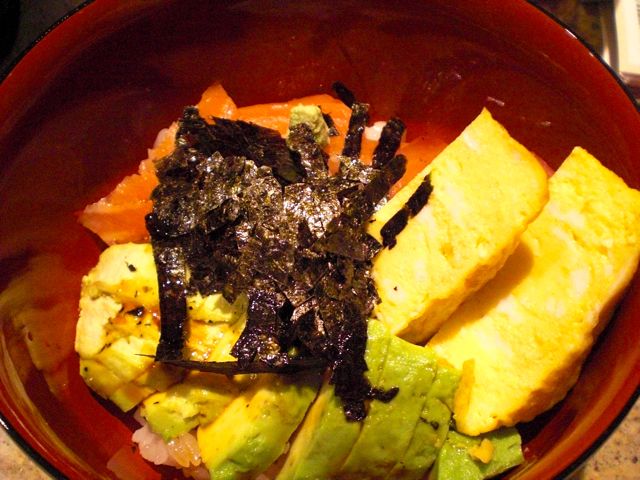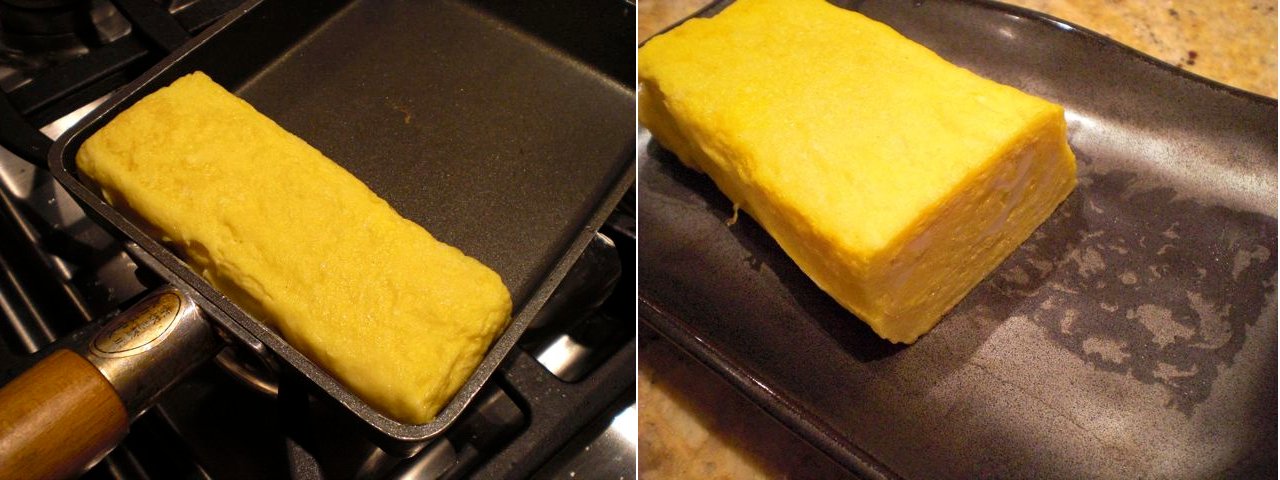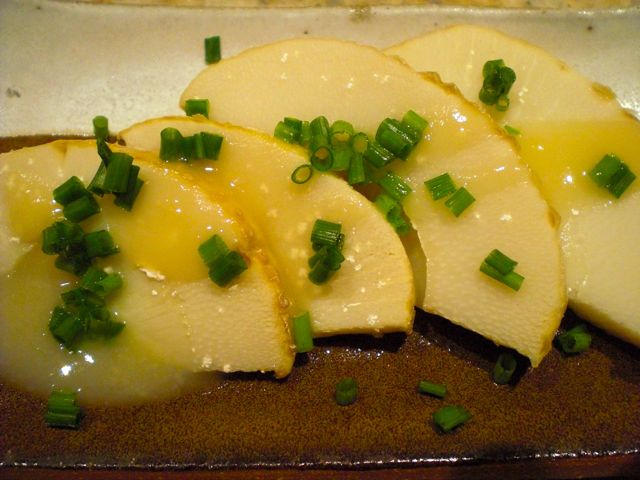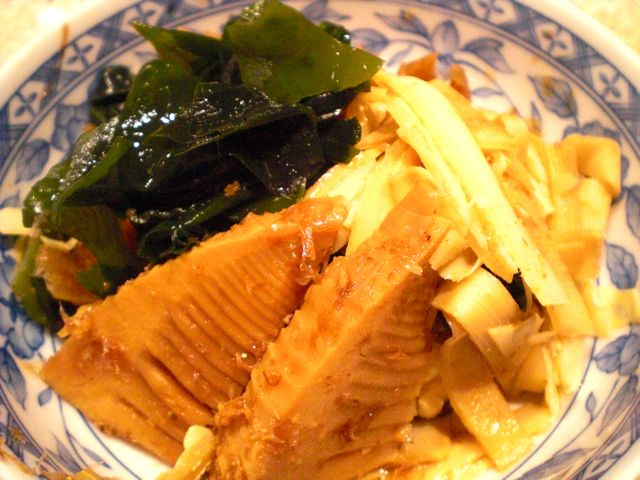Again nothing special but the combination worked well. We had this with a glass of red, Maroon Winery Spring Mountain District, Napa Valley Cabernet Sauvignon 2007. Despite vinegar in the dressing (the dressing is sightly sweet from honey and rice vinegar is mild), this salad went well with this wine. After this, I made three tuna sashimi dish from frozen yellow-fin tuna including tuna and avocado cubes, tuna "zuke" sashimi, and Yamakake. We switched to a U.S. brewed Gekkeikan sake, "Black and Gold", surprisingly pleasant sake and we enjoyed both the sake and the food. Only problem was that this was Sunday evening instead of Saturday or Friday.
Thursday, February 24, 2011
Duck breast and avocado salad 鴨の胸肉とアボカドのサラダ
This is another one of making-something-from-leftover dishes. We had leftover roasted duck breast. I thought I was making a starter dish for sake but I was told that we were having red wine instead. So I had to change my menu on a dime and came up with this starter.

This is just a small salad consisting of greens (baby arugula and spinach), avocado, tomato, cucumber and sliced duck breast. The avocado was nicely ripe and made this dish. The avocado was cut into 1/2 inch cubes. I cut the cucumber in my usual snake belly fashion and then cut into half inch segments. Campari tomato was skinned, peeled and quartered. The duck breast was thinly sliced and halved. The dressing is my usual mustard, honey dressing (Dijon mustard, honey, finely chopped shallot, rice vinegar, olive oil with salt and pepper).
Tuesday, February 22, 2011
Japanese omelet and smoked salmon avocado sushi だし巻きとスモークサーモン、アボカドちらし寿司
One weekend evening, we had a series of small dishes with sake as usual. Among others, I prepared marinated tuna or maguro-zuke. The next day I saw the container I had used for the tuna in the refrigerator and thought 'we must not have eaten it last night because we were too full." So, in great anticipation, I planned to have tuna-zuke donburi ま ぐろ漬け丼 for dinner. But when I opened the container, there was no tuna inside--just the marinade. I asked my wife where the tuna was. She said she didn't know about the tuna in the container but we had eaten tuna the night before and, by the way, it was really good. I asked why she put the container back in the fridge when there was no tuna in it? She told me that she didn't know tuna was involved with the container but she did know, from experience, not to throw out any liquid in a container she may run across while cleaning up, whether or not she knew what it is used for. So, I had to change gears and make something else, especially since (at my request) my wife had prepared freshly cooked rice for the marinated tuna dish.

Since we had half an avocado (left over from the tuna and avocado cubes I made the night before) and smoked salmon, I decided to make this smoke salmon avocado scattered sushi. To make this dish more interesting, I decided to add "dashimaki" だし巻き or Japanese omelet. I have previously posted variations of dashimaki.
I sliced the omelet into one inch thick slices and then cut each slices in diagonal. I placed them on the vinegared rice as seen in the first image. After placing slices of smoked salmon, and sliced avocado, I added a small mound of real wasabi and sprinkled soy sauce on the avocado. I garnished it with nori strips. Marinated tuna would have been better but this is a mighty good "shime" 締め.

Traditionally this is served with grated daikon. Add a little soy sauce when eating. The side is my drunken tomatoes and cucumber dressed in sushi vinegar.
Dashimaki: This is a regular item in Izakaya and sushi bar*. "Otsumami yokocho" also have the recipe (volume 1, p64) but this is a rather standard affair and I made it in the way I usually make it. Although you could make this in a regular round frying pan, to make the omelet in a proper rectangular shape, you need to use a rectangular frying pan. I have a small home-cook version with a nonstick surface as seen below.
*Especially in Kyoto, dashimaki appears to be extremely popular. We found stores in Nishiki market 錦市場 specialized in all kinds of dashimaki variations. In the morning, in one such store, we saw 5-6 cooks lined up shaking large square pans up and down making dashimaki to be sold for the day. Many Kyotoites appear to just come and buy these large rectangular omelets.
I used brown eggs (3 large), dashi broth (3 tbs or 1 tbs per egg), sugar (3 tsp or more if you like it sweet) and salt (a small pinch). I mixed all ingredients using cooking chopsticks. In a square frying pan on medium-low flame, I add vegetable oil (1/2 tsp) and add the egg mixture (just enough to cover the bottom in a thin layer. As the bottom sets but the surface is still wet or uncooked, I start rolling from one end using chopsticks and/or silicon spatula (If you are a dashimaki Jedi, you use only chopsticks). You repeat this several times and keep rolling. It is important to lift the already cooked omelet so that the new egg mixture will flow under it. For my pan, three eggs makes a perfect rectangle omelet which is even with the height of the pan's edge (left lower). I press against the vertical rim to make the two long ends straight. Here is a visual aid by a pro.

Since my omelet was near-perfectly formed, I did not have to use a sushi bamboo mat to shape the omelet. On the right above, you can see the cut surface with multiple layers.
Sushi Rice: As usual, I used sushi vinegar from the bottle. I added as much as the rice would absorb. I let it sit for few minutes after the rice was lightly mixed while the rice was fanned (by my wife).
I sliced the omelet into one inch thick slices and then cut each slices in diagonal. I placed them on the vinegared rice as seen in the first image. After placing slices of smoked salmon, and sliced avocado, I added a small mound of real wasabi and sprinkled soy sauce on the avocado. I garnished it with nori strips. Marinated tuna would have been better but this is a mighty good "shime" 締め.
...and also as a starter dish for the next evening.
Sunday, February 20, 2011
Octopus "butsu-giri" in miso-vinegar sauce 鮹のぶつ切りのからし酢みそ和え
The "drunken" grape tomatoes (smaller than cherry tomato) were leftovers. I made them based on a recipe called "Bloody Mary" on a stick by Frugal gourmet. The original recipe calls for soaking the tomatoes in Vodka but I did not have any. So instead, I soaked the tomatoes in gin with dry vermouth making them "martini" on a stick. Here is the recipe; I skinned the grape tomatoes (by blanching). Then put them in a container of "martini" and left them to enjoy themselves in the fridge for several days. I served them with a small mound of kosher salt on the side and toothpicks to dip them into the salt. The end product has a nice gin flavor and the tomato is sweet. It is a very nice dish. We particularly like the burst of flavor when we bite down on them. Of course, one of us has to drink up the marinade when we finish all the tomatoes (hardship!).
Finally, octopus with miso-vinegar dressing. I just used an end piece of boiled octopus leg. "Butsu-giri" ぶつ切り means simply "cut into chunks". By cutting this way, it has a different texture than when it is thinly sliced. I just used my usual "Karashi sumiso" からし酢みそ made of saikyo miso 西京味噌(2 tbs), Japanese hot mustard (1/2 tsp from a tube), rice vinegar (1 tbs). I added mirin to adjust the thickness and sweetness of the sauce.
All items are intended to go with sake and they were indeed good pairing for sake. Martini and sake in the same offering--what's not to like?
Friday, February 18, 2011
Broiled bamboo shoot with sumiso sauce 焼きタケノコの酢みそがけ
This is from "Otsumami Yokocho" Volume 1, Page 63. When I made the simmered bamboo shoot with wakame seaweed dish, I set aside the bottom 1/3 of the bamboo shoot and made this dish the next day. I never had a bamboo shoot this way before. I was curious to see how it would turn out. It turned out to be a very simple but good dish.

Bamboo shoot: I used the bottom 1/3 of a vacuum packed boiled bamboo shoot (top 2/3 was used for another dish). I cut the bottom in half lengthwise and then made thin (1/4 inch) half moon slices. I washed off the chalky white stuff (congealed tyrosine) so that the dish would be more presentable. I blotted the shoot dry with a paper towel. I used my toaster oven to broil the bamboo shoot. I broiled it for about 5 minutes. When the edges became brown, I turned them over and broiled them another 4-5 minutes.
Sumiso sauce: I added Saikyo miso 西京味噌 (1 tbs), mirin (1 tbs) and rice vinegar (1/2 tbs) in a suribachi or Japanese mortar and mixed them until it became a smooth sauce.
I arranged the broiled bamboo shoot on a small plate, poured the sauce over and garnished with finely chopped chive as seen above.
This is a nice way to enjoy bamboo shoot. You can really experience the subtle flavor and nice crunchy texture of the shoot. The sauce was very complimentary to the bamboo shoot. It went perfectly with the cold sake we were having.
Wednesday, February 16, 2011
Flavored rice ball with beef slices in miso sauce おにぎりと牛肉の薄切りの味噌和え
This is, again, not really post-worthy but I am posting this to make the point that you need to improvise on short notice when eating and drinking at home. This was a small "shime" dish we had on a weeknight, from leftovers. We started with some snacky-snacks (cheese with crackers, roasted cashew nuts and such) and "snap pea in broth", progressed to grilled chicken thigh 鶏の塩焼き with celery salad with kelp tea powder セロリの昆布茶サラダ, and finished with this "shime" 締め. For most people (especially some fellow bloggers or blog-eagues), the amount of food is not enough or not even close, I am sure.

Rice ball おにぎり: This was from yesterday's cold (but not frozen) rice. I first microwaved and mixed with perilla seedpod tsukudani 紫蘇の実の佃煮, made it to a cylindrical shape and wrapped with a strip of nori.
Beef with miso sauce: I had leftover flat iron steak which was cooked medium rare. I sliced it very thinly across the grain. In a small frying pan, I added sesame oil (1/2 tsp) and chopped scallion (1 tbs) and sauteed for a few minutes and added miso (2 tbs). After a minute or so, I added mirin (2 tbs) and stirred. While the sauce was still loose I placed the slices of steak on top to warm them but I did not mix them with the sauce. After a few minutes, when the meat was warmed through, I removed the meat and placed it on a small serving plate. I turned the flame to medium and reduced the miso mixture to make the consistency firmer (not to the level of the original miso consistency though). I poured the miso sauce on top of the meat.
I could have served the thinly sliced steak on top of greens with Japanese style dressing (sesame oil, rice vinegar, soy sauce) or I could have served them with sliced cucumber and/or daikon with ponzu sauce and so on.
I also added asazuke 浅漬け of daikon, nappa cabbage and cucumber. Probably I should have made two rice balls per person even for us.
Monday, February 14, 2011
Simmered Bamboo shoot with Wakame 若竹煮もどき
Newly harvested bamboo shoots are a sign of spring in Japan (not in Hokkaido, though, it is too cold for big bamboo to grow). When bamboo is cooked with fresh wakame sea weed, it is called "Wakatake-ni" 若竹煮 and is considered the ultimate combination of two seasonal food items in spring. My dish is not quite authentic; first of all, I made this from a vacuum packed boiled bamboo shoot and second, the wakame I used is not fresh or even salt preserved but dried. "Otsumami yokocho" volume 1 on page 44 has a similar but more simplified version of this dish. In the U.S., both bamboo shoot and fresh wakame are "out of season" so this is the best I can do for this dish.

The boiled bamboo shoot I bought at a near-by Japanese grocery store had "Himekawa" 姫皮 attached (left image). Himekawa is the very soft top inner part of bamboo shoot. I removed this first and cut it into strips. I was initially thinking of using this for a different dish such as a Japanese "ae-mono" salad but I got lazy and decided to use it in this dish as well. I added "himekawa" to the pot just before serving to warm it up and season. You need not really cook this part further.
The boiled bamboo shoot I bought at a near-by Japanese grocery store had "Himekawa" 姫皮 attached (left image). Himekawa is the very soft top inner part of bamboo shoot. I removed this first and cut it into strips. I was initially thinking of using this for a different dish such as a Japanese "ae-mono" salad but I got lazy and decided to use it in this dish as well. I added "himekawa" to the pot just before serving to warm it up and season. You need not really cook this part further.
I cut off the lower 1/3 (I intended to use the lower part for other dish) and cut the top portion in quarters lengthwise. Then I further cut it into small wedges. You may find chalky white stuff between the segments of bamboo shoot. This is an amino acid (tyrosine) congealed. Tyrosine is not water soluble and is contained abundantly in the bamboo shoot itself. As such, it is not harmful and OK to eat but, for a better presentation, you may want to wash off most of the visible ones.
I put dashi (1 cup), mirin (1 tbs), sake (1 tbs) and soy sauce (2 tbs) in a small pan on medium flame. If you want to keep the light color of the bamboo shoot, use a light colored soy sauce or "usukuchi shuyu". When it comes to a boil, turn the heat down to simmer. I cook it for about 20-30 minutes or until the cooking liquid is reduced in half. Just 1 minute before serving, I add "himekawa" and hydrated wakame to warm them up but not really "cook" them. To serve, I first place the wakame (left, back in the above picture) and "himekawa" (right, back) in a sallow bowl. I took out the cooked bamboo shoot in another bowl and added bonito flakes and mixed to coat (optional) and served them next to the wakame and himekawa as seen above.
For dried wakame and vacuum packed bamboo shoot, this was not bad. We had this with cold sake as a second dish after we had the avocado and tunas sashimi cubes, a very nice contrast.
Saturday, February 12, 2011
Cornish game hen with ratatouille and baked cauliflower and green beans コーニシュ ゲーム ヘン と ラタトゥイユ
I posted barbecued Cornish hens before . This is the second best way to have Cornish game hen especially on a weeknight. Since we are not barbecuing, it may not have enough taste, thus, requiring prior marination.
On one weekend, we made a couple of vegetable dishes including ratatouille, baked green beans, and baked cauliflower with back olive and garbanzo beans. I cooked a Cornish game hen on Monday evening with these vegetables as side dishes. Because the bird is small, it cooks rather quickly. I pan-fried and then finished it in the oven.
I remove the back bone using kitchen shears by cutting lengthwise across either side of the bone. I flatten the bird on the cutting board skin-side down and then cut the breast bone lengthwise in half using a heavy chef's knife making two halves of the hen. I marinated the hen over night in the refrigerator using a mixture of olive oil, lemon juice, crushed garlic, roughly cut stalks of green onion, salt and pepper. Essentially, you are marinating the birds in French vinaigrette. You could add herbs like rosemary or tarragon. The next day, after draining, the marinade, I pat dry the surface with a paper towel and lightly sprinkle salt and pepper. In a frying pan, I add olive oil (1 tbs) and cook the skin side down for 5-7 minutes until the skin become brown. You may have to blot the excess oil using paper towels during this process. I flip the bird over and finish cooking in a 400F convection oven for about 15 minutes or maybe a bit longer. After 15 minutes, take the temperature at the thickest thigh part if or when it registers 160F or higher, remove the bird to a plate and loosely cover with aluminum foil and let it rest for 10 minutes. Meanwhile, I make a simple pan juice sauce. If there is too much oil in the pan, remove most of it (leaving 1-2 tsp) by blotting with a paper towel. Put the pan on a medium flame and add finely chopped shallot and saute for 1-2 minutes, de-glaze with dry red wine (1/4 cup) (white wine, Marsala, or white vermouth will also work), reduce the liquid by half. Add any juice accumulated on the plate on which the bird is resting. I finish the sauce by adding and emulsifying with pats of butter. Usually it does not need additional salt and pepper since these come off the surface of the bird to the pan while cooking.
The only way to enjoy a Cornish game hen is to use your fingers and go at it. The meat is more succulent than its larger cousin and the skin, especially of the wing, is crispy.
Subscribe to:
Posts (Atom)


